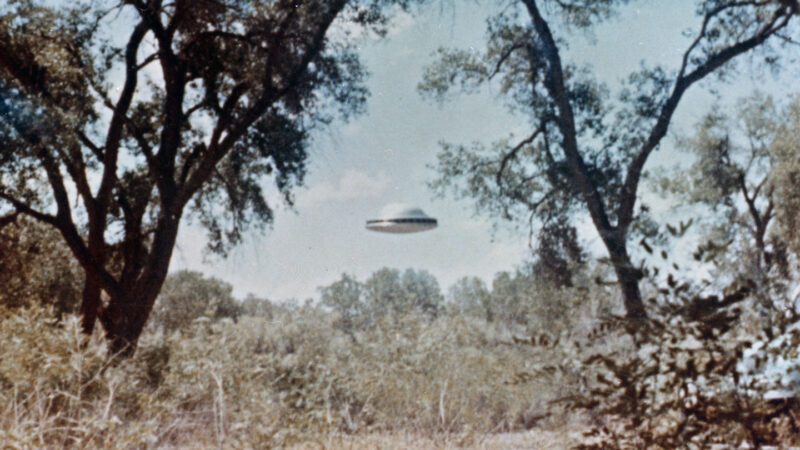In 2015, U.S. Navy pilots were flying training missions off the U.S. East Coast when they spied something highly unusual. An oval-shaped object appeared to skim across the top of the water. It moved at incredibly high speed and seemed to be rotating as it flew. Soon, the pilots realized there seemed to be many of them and started commenting to each other about what they were seeing.
“There’s a whole fleet of them.”
“My gosh.”
“Look at that thing, dude!”
“Wow. What is that, man? Look at it flying!”
Pilots had seen similar objects almost daily for months. These didn’t look like typical aircraft. They had no visible engines. They didn’t seem to give off exhaust. And they didn’t just skim the sea. Some appeared 30,000 feet (more than 9 kilometers) in the air and moved at supersonic speeds.
Hardly quacks or UFO fanatics, these were highly trained pilots. And they weren’t newbies, either. One who reported the sightings was Lt. Ryan Graves, an F/A-18 Super Hornet pilot. He had been in the Navy for 10 years. He and the others knew what normal aircraft looked like. They also knew how to keep their cool under pressure.
The public only became aware of their sightings four years later. That’s when The New York Times published an article about them. The online article included leaked video recorded by cameras on the Navy planes. In April 2020, the U.S. Navy confirmed those videos were real — and then officially released them.
In 2020, an international service shared these videos captured in 2015 by U.S. Navy pilots watching a UAP. The military only formally released the video in April of 2020.
In recent years, these and other very credible sources have reported seeing UFOs — unidentified flying objects. Now they’re called Unexplained Aerial Phenomena, or UAP. But whatever you call them, the U.S. government has lately begun taking these mystery objects seriously. Very seriously. And it’s recruited a lot of scientists to investigate what’s behind them (albeit quietly).
We still don’t know what the pilots and others have seen. But here’s what’s motivated the new and growing scientific interest in them.
The summer of UFOs
Military pilots reporting UFOs may be new. The public, however, has reported UFO sightings for decades. It began in the summer of 1947.
On June 14 of that year, Mac Brazel found some strange debris on his ranch. The ranch sits on the outskirts of Roswell, N.M. He thought the material might be a kite. However, he couldn’t reassemble the bits of rubber, tinfoil, paper and wood strips into anything that looked like a kite.
Brazel told the local sheriff what he’d found. The ranch was near Roswell Army Air Field (RAAF), a military base. So the sheriff reported this to the Army.
Officers from RAAF went to the ranch for a look. They couldn’t identify the wreckage, either. The next day, the Army base issued a press release saying that the military had found remnants of a flying saucer.
The local newspaper even ran the headline: “RAAF Captures Flying Saucer on Ranch in Roswell.” A few days later, the Army changed its story. They said the debris came from a weather balloon. But it was too late to dampen the excitement about flying saucers. UFO fever had gripped the nation.
And since then, it’s never let go.
Here’s how one local newspaper reported the Army’s report on analysis of debris found at the Brazel farm in 1947.Roswell Daily Record’s Roswell IncidentHere’s how one local newspaper reported the Army’s report on analysis of debris found at the Brazel farm in 1947.
The government comes clean
UFOs are real. There’s no question about that.
The term simply means the witnessed object is unknown and moving through the air. If you see something in the sky that you can’t identify, then by definition it’s a UFO. But when people ask if UFOs are real, what they usually mean is: “Are we being visited by aliens?”
And science certainly has no answers yet for that.
After Roswell, people started reporting lots of UFOs. Some witnesses made wild claims they couldn’t back up. Someone might say they’d encountered an alien. Some even claimed to have been abducted by aliens. But there was never any physical evidence to support such statements.
Soon conspiracy theories started circulating. People said they’d heard an alien spaceship had crashed in Roswell. They shared rumors that the government had stashed away bodies of aliens who’d died in the crash. Those bodies were allegedly kept in a secret installation in Nevada known as Area 51.
These stories were ridiculous. But still they spread.
The government didn’t help much. It had secrets of its own that had nothing to do with aliens. Eventually, the government admitted it had been hiding something — it just wasn’t little green men. A 1995 Air Force report tried to put the hidden-aliens story to rest. It said the debris that landed on the Brazel ranch had not been a weather balloon after all.
It was part of Project Mogul — a secret program to develop balloons that could identify and track Soviet missile launches. (Remember, this happened in 1947, during the Cold War. At that time, the United States and the Soviet Union were stockpiling nuclear weapons in case of another world war.)
The Air Force also explained away the alien “bodies” that people thought they had seen. These were crash-test dummies used to test ejection seats in experimental aircraft.
Coming clean about Roswell didn’t end the conspiracy theories, however. Wild tales continued. And for years the government didn’t say much more about UFOs.
But when the story about the 2015 Navy pilot sightings broke, the government began to talk more openly about UFOs.
Do you have a science question? We can help!
Submit your question here, and we might answer it an upcoming issue of Science News Explores
Congressional hearings and government reports
In 2021, the government released a brief report. It had turned up no evidence of aliens. It did admit, however, that many UAP sightings have been recorded since 2004. And they remain unexplained.
That doesn’t mean these were craft built or piloted by aliens, of course. There are probably several explanations, the report said. Some might be birds. Others might be trash, such as escaped party balloons. Some could be secret military projects. And some might be new technology developed by other countries.
That last one is what concerned many members of Congress and the military.
The next spring, in May 2022, Congress held a public hearing on UFOs. High-ranking officials from the military testified. They said 400 more unexplained sightings had been reported since the 2021 report. Still, nothing pointed to aliens.
Scott Bray testified at the hearing. Deputy Director of Naval Intelligence at the time, he explained why the government wasn’t saying much about these sightings: “We do not want potential [military enemies] to know exactly what we are able to see.” (Bray now works in intelligence for NATO, an international military alliance.)
Then, in July 2022, the Pentagon created AARO. That stands for All-domain Anomaly Resolution Office. Its job is to investigate UFOs. Again, the government doesn’t call them that anymore. Their term is UAP. In fact, that name change was an attempt to remove some of the stigma associated with the study of UFOs.
The military now wants to know if these objects are a threat. Science will settle for a simpler answer: What are they?
Astronomers are enlisting new technologies in the quest to answer one of the most intriguing research questions of all: Are we alone in the universe?zhengzaishuru/iStock/Getty Images Plus
Scientists step up
There’s reason to think we probably aren’t alone in the universe. Earth is 4.5 billion years old. The earliest life on Earth is 3.5 billion or maybe 4 billion years old, explains Seth Shostak. This astrophysicist is senior astronomer at the SETI Institute. That’s in Mountain View, Calif. (SETI stands for Search for Extraterrestrial Intelligence.)
Life on Earth emerged fairly quickly. This suggests, Shostak says, that it wasn’t hard for life to begin. And if it quickly started on Earth, life probably could have started in many other places throughout the cosmos, too.
And there are plenty of other places.
There are a trillion planets in the Milky Way alone. And that’s just our galaxy. There may be more than a trillion habitable planets in the universe, Shostak says. “So yeah,” he adds, “there’s plenty of opportunity for life.” But that still doesn’t mean that aliens have been visiting Earth.
Julia DeMarines is an astrobiologist. She studies how life might evolve on other planets. DeMarines works at the University of California, Berkeley and is a former SETI observer. SETI researchers look for signs of life elsewhere in the universe. They don’t study UFOs. Few scientists do.
Astrobiologist Julia DeMarines describes her favorite research — the search for life beyond Earth — and how she tries to identify signatures of possible extraterrestrials.
Until recently, DeMarines says, most scientists described the study of UFOs as pseudoscience. No surprise, then, that scientists who are interested in UAP have seldom talked about it. They didn’t want other scientists to think they’re kooks.
But that’s changing.
In June 2022, NASA assembled a team of scientific experts. Their mission: Figure out how NASA can help study UAP.
As Bill Nelson, the space agency’s administrator, put it: “NASA searches for the unknown in air and space. It’s in our DNA.” One of the goals of the new team, he said at a news event, would be to “shift the conversation about UAP from sensationalism to science.”
The team made some specific recommendations. For instance, it said NASA should use its enormous body of space data for this study of UAP. And it should work with other government agencies to investigate reported sightings. The team also emphasized that all UAP studies must stay focused on evidence and data.
Avi Loeb agreed. And he wanted to help. Loeb is an astrophysicist at Harvard University in Cambridge, Mass. “To study those things,” he argues, “is the duty of scientists.”
Avi Loeb of Harvard holds a few of bits of debris from a space object of unknown origin and type: a UFO. Some melted bits have a very unusual composition. They appear to be materials never before seen in our solar system.Galileo Project, led by Professor Avi Loeb (Harvard)
In 2021, Loeb started the Galileo Project to scientifically investigate UAP. It doesn’t collect stories about UAP. It doesn’t rely on accidental sightings. Instead, it scans the skies with telescopes in an observatory at Harvard.
“We basically take a movie of the sky,” explains Loeb. Then artificial intelligence helps analyze the data. Two more observatories are in the works. Loeb hopes to have 10 eventually. More than 100 scientists are already involved.
This is different from what AARO is doing, says Loeb. “Their job is to protect national security. I’m trying to figure out the world.”
Loeb and his team are not the only ones. NASA’s involvement changed things, says Greg Eghigian. He’s a historian at Penn State University in University Park. He wrote a book titled After the Flying Saucers Came: A Global History of the UFO Phenomenon. NASA’s involvement was a signal to scientists that talking openly about UAP is OK, Eghigian says. It allowed scientists to discuss ideas that had been taboo.
More mysteries
Now that science is on the job, what can we expect to learn about UAP and maybe even alien life? One possibility is that science may be able to explain the previously unexplained.
DeMarines says UAP could be due to some unusual weather conditions. For example, spacecraft launched from Earth around sunset can create weird effects. When the sun is setting, she explains, gases expelled by the spacecraft will reflect only that light reaching the upper atmosphere. What’s more, she adds, “They stay reflective for a long time. So it looks unexplainable.”
Or UAP could be an effect caused by light bouncing off communications satellites, Loeb says. And, of course, it could be technology not from another planet, but from another country on this one.
But what about aliens? Could UAP really be alien spaceships?
Let’s learn about the hunt for alien life
Garrett Graff is a historian and author. He wrote the 2024 book UFO: The Inside Story of the US Government’s Search for Alien Life Here — and Out There. While doing research for it, he noticed something people often get wrong when they think about aliens and UAP. “We expect first contact with alien life to be like it is in movies, like Independence Day or Contact,” he says. But in real life, he notes, it might not be that obvious.
Our first encounter with aliens, Graff says, might not be meeting them. It might be finding remnants of their tech.
For example, we might find a piece of space trash that doesn’t come from our world. Graff compares this to spotting an empty plastic bag blowing through our cosmic backyard. We look at it and think: “That’s not from our Walmart.” We’ll know it didn’t originate on Earth, but we won’t know where it did come from.
Will we know alien life when we see it?
One reason we may not see the aliens themselves is that they may no longer exist. In 1961, astronomer Frank Drake came up with a way to estimate how many alien societies could be broadcasting signals. It’s called the Drake Equation. It accounts for several factors. These include the rate at which stars form and the number of planets with an environment that might support life — the “Goldilocks zone.”
But the last factor in Drake’s equation is very interesting, says DeMarines. It’s represented by the letter “L.” That stands for the length of time technological civilizations produce signs of their existence. These could be radio waves, pollution from industry or even city lights.
DeMarines points out that our civilization has been technologically advanced for little more than 100 years. And that’s in a universe that’s almost 14 billion years old. Her point is that the timing might not overlap. There may have been many other civilizations like ours. And there may be many more to come. But the chances that ours and theirs occur at the same time aren’t terribly good, she says.
Cool Jobs: Reaching out to E.T. is a numbers game
Shostak, however, thinks it won’t be long until we find alien life, or at least evidence that it’s out there somewhere. “There have been 10,000 generations of Homo sapiens,” he says. “And the people reading this article are probably members of the first one in which we learn that there’s life in outer space.”
So what about UAP? Is there evidence that alien life is visiting Earth? Science is on the case.

















